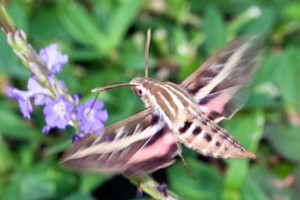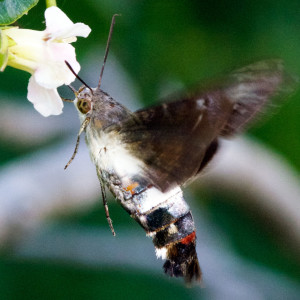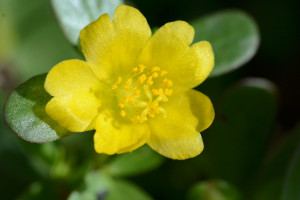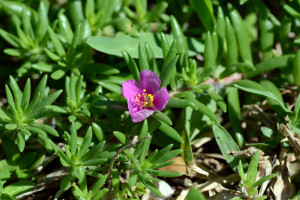One gray and overcast morning near the end of October I saw a large moth nectaring from the porterweed and petunia patch out front. I took a terrible video with my phone, then ran inside for my real camera with its real macro lens and ran off thirty shots in hopes of getting something useful for ID purposes. And sure enough, shot number thirty (thank goodness!) was enough to ID it, although it certainly wasn’t an aesthetically pleasing portrait of this actually quite lovely moth:

The wings in the picture above are blurry with motion; that’s because they have to beat very fast to keep this rather fat moth airborne. The large size and the strong wingbeats have given this moth another common name, in addition to the rather “technical” white-lined sphinx: the hummingbird moth.
That’s not a specific name, though; several other large moths are also known as hummingbird moths.
However, if you take the trouble to do an image search, you’ll find that this is probably the prettiest of the hummingbird moths. It’s fairly widespread, too. The page at BAMONA (that’s Butterflies and Moths of North America) mentions that it’s found on at least three continents:
Range: Central America north through Mexico and the West Indies to most of the United States and southern Canada. Also occurs in Eurasia and Africa.
The reason for that large home range is that it’s a generalist: its larvae can feed on many different plants:
Caterpillar Hosts: A great diversity of plants including willow weed (Epilobium), four o’clock (Mirabilis), apple (Malus), evening primrose (Oenothera), elm (Ulmus), grape (Vitis), tomato (Lycopersicon), purslane (Portulaca), and Fuschia [sic].
This is the fifth “sphinx” I’ve found on the property (the previous four being Xylophanes pluto, Erinnyis ello, Manduca sexta, and Enyo lugubris). All of these moths are quite large and very interesting to look at.
Actually, this is the sixth sphinx moth I’ve found, but I don’t have a solid ID on the fifth one yet. One of the commenters at bug guide.net thought it was probably Aellopos sp., probably Aellopos tantalus, but the jury’s still out:

Still and all, large day-flying moths, while nowhere near as common in my yard as their cousins the butterflies, do provide some interest.
And these particular moths, the white-lined sphinx, since one of their larval host plants is purslane, give me a reason not to pull up the rather large patches of purslane “weeds” in my beds of golden creeper:


The yellow-flowering purslane is probably Portulaca oleracea; I also have a pink-flowering version, Portulaca pilosa, that’s quite pretty as well:

And I haven’t felt the need to get rid of these low-growing “weeds.” That really is one of the best parts of gardening for wildlife: you can tolerate weedy species that have redeeming qualities.
Cheers!
PS—I have no idea where the genus name comes from. In Greek mythology, Hylas was a companion of Herakles, but I haven’t been able to find any info about any Hyles. In medieval Latin, hyle was used as a transliteration of the Greek húlē, wood, matter; in another sense, the first matter of the cosmos, from which the four elements arose, according to the doctrines of Empedocles and Aristotle.
It isn’t immediately apparent why it was applied to this particular genus.
